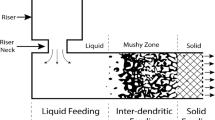Abstract
Spheroid Ductile Cast Iron finds increasingly industrial use as a high strength material of high fatigue resistance. The material properties can be designed by density, shape and size of the graphite spheres—the nodularity—and the matrix microstructure. Until today, the near surface nodularity cannot be controlled nondestructively to take full advantage of the material quality especially at high loaded surface areas. A viable nondestructive approach we propose is based on ultrasonic backscattering preferably in the Rayleigh regime. First experiments with model samples proved significant contrast to distinguish materials with different graphite morphology and matrices. The claim of our tests is a fast and easy industrial control of nodularity in reference to a validated sample. The results encourage us for the development of a prototype equipment with optimized probe systems and inspection parameters. Quantified acceptance criteria still require systematic tests for optimized parameter settings and probe configurations on more representative samples provided by industry.






Similar content being viewed by others
Notes
Siempelkamp Maschinen- und Anlagenbau GmbH, Krefeld, Germany.
Q-NET Engineering GmbH, Saarbruecken, Germany.
References
Komatsu, S., Shiota, I., Nakamura, K., Kyogoku, H.: Relation Between Microstructure Size and Ductile-Brittle Transition Behavior in Fracture Toughness of Ferritic Nodular Cast Iron, Phys. Metallurgy of Cast Iron V. Scitec Publications, Zug (1997)
European Standard: Cast Iron. Designation of microstructure of graphite, EN-ISO 945, CEN, confirmed 1994-12-05 (2006)
Metzloff, K.E., Loper, C.R.: The effect of metallurgical factors and heat treatment on the elastic modulus and damping in ductile and compacted graphite iron. Int. J. Cast Met. Res. 16(1–3), 239–244 (2003)
Alagarsamy, Al: Sound Advice for Nodularity Testing, Modern Casting, pp. 31–34. American Foundry Society Inc, Schaumburg (2005)
Lord, R.: The Theory of Sound, Dover, New York, 1945, (First publication: Rayleigh, J.W.S, Lindsay, R.B. (eds.) Theory of Sound, Macmillan, London, UK (1878)
Salchak, Y.A., Sednev, D.A., Kroening, M., Ardashkin, I.B.: Method of case hardening depth testing by using multifunctional ultrasonic testing instrument. IOP Conference Series: Materials Science and Engineering, vol. 81, No. 1, 012080, IOP Publishing (2015)
Kroening, P., Mueller, T.: P3121—Case Depth Tester Training Manual. Q NET Engineering GmbH, Saarbruecken, Germany (2018)
Teh, B.G., Cloutier, G.: Modeling and analysis of ultrasound backscattering by spherical aggregates and rouleaux of red blood cells. IEEE Trans. Ultrason. Ferroelectr. Freq. Control 47(4), 1025–1035 (2000)
Shutilov, V.A.: Fundamental Physics of Ultrasound (Osnovy fisiki ul`trazvuka), Gordon and Breach, Amsterdam, ISBN 2-88124-684-2 (1988)
Godbole, S., Jayashree, V.: Microstructure analysis of spheroidal graphite iron (SGI) using hybrid image processing approach. Int. J. Adv. Res. Comput. Eng. Technol. 3(7), 6 (2014)
ISO 945-1: Microstructure of cast irons—part 1: graphite classification by visual analysis, CEN (2017)
Kroening, P., Mueller, T.: Technical Description for Hardness Depth Tester, Type P3123. Version 1.8, Q NET Engineering GmbH, Saarbruecken, Germany (2018)
Peoples, R.B.: Nondestructive ultrasonic testing is an ideal tool to measure the nodularity of cast parts, Quality Magazine, April 1st (2017)
Acknowledgements
The research was funded by the Governmental program “Science”, Research Projects No. 11.3683.2017/4.6 and No. 11.6342.2017/8.9 and as well as by Tomsk Polytechnic University Competitiveness Enhancement Program grant, the Project No. VIU-IShNKB-77/2019. The sponsoring makes possible the collection, analysis and interpretation of data. We thank our industrial partners, Q-NET Engineering GmbH, Saarbruecken, Germany, and Siempelkamp Maschinen- und Anlagenbau GmbH, Krefeld, Germany for their professional support. The research would have not been possible without the European INTAS program through which a young scientist could work in a foreign laboratory. Cooperation and exchange of ideas create trust and friendship and good results.
Author information
Authors and Affiliations
Corresponding author
Additional information
Publisher's Note
Springer Nature remains neutral with regard to jurisdictional claims in published maps and institutional affiliations.
Rights and permissions
About this article
Cite this article
Bolotina, I., Kroening, M., Sednev, D. et al. Nodularity Control of Spheroid Ductile Cast Iron by Rayleigh Backscattering. J Nondestruct Eval 39, 4 (2020). https://doi.org/10.1007/s10921-019-0645-y
Received:
Accepted:
Published:
DOI: https://doi.org/10.1007/s10921-019-0645-y




